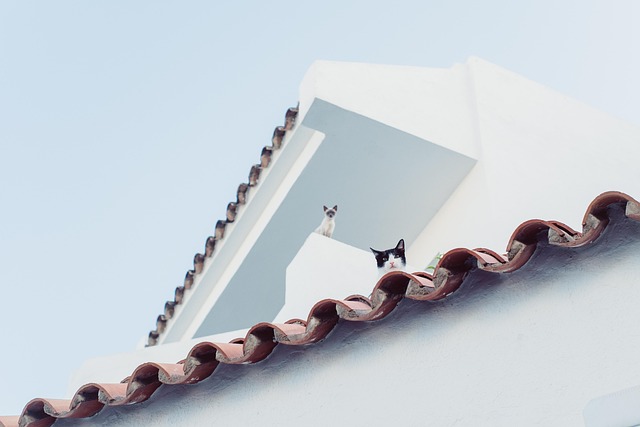Cool roofs, an innovative and environmentally friendly roof installation solution, reflect solar radiation, significantly reducing energy consumption for cooling in both hot and cold climates. By utilizing advanced technologies like reflective coatings and lightweight insulation, these roofs stay up to 30°C cooler, lowering electricity demands and carbon emissions. Gaining popularity globally, cool roofs offer long-term cost savings, aesthetic appeal, and ecological benefits, contributing to sustainable cities and greener living.
In today’s quest for sustainable living, homeowners and businesses are increasingly turning to environmentally friendly roof installations. Cool roofs, designed to reflect heat rather than absorb it, offer a promising solution to reduce cooling costs and mitigate the urban heat island effect. This article explores the concept of cool roofs, delves into the benefits, highlights eco-conscious materials, provides real-world case studies across diverse climates, and discusses their promising future in energy-efficient roofing.
Understanding Cool Roofs: The Concept and Its Benefits
Cool roofs, an innovative solution in sustainable building design, are designed to reflect a significant portion of solar radiation back into space, rather than absorbing it as heat. This simple yet powerful concept has far-reaching benefits, particularly in mitigating the urban heat island effect and reducing energy consumption for cooling. By choosing environmentally friendly roof installations that incorporate cool roof materials, buildings can lower their carbon footprint and contribute to more sustainable communities.
The primary advantage lies in its ability to reduce the need for air conditioning, thereby lowering electricity demand and associated emissions. Traditional roofs absorb heat, leading to increased interior temperatures and higher cooling costs. Cool roofs, on the other hand, stay up to 30°C cooler than conventional ones during hot weather, creating a more comfortable indoor environment without relying heavily on energy-intensive cooling systems. This benefit is especially valuable in urban areas where concrete and asphalt structures contribute to elevated temperatures, making cool roofs a game-changer for sustainable city planning.
Environmentally Friendly Materials for Sustainable Roofing
When considering environmentally friendly materials for roofing, options like cool roofs stand out as a sustainable choice. These innovative designs are specifically engineered to reflect sunlight and heat, significantly reducing the amount of energy absorbed by buildings. This not only minimizes cooling costs but also contributes to a greener planet by lowering overall energy consumption. Cool roof installations utilize advanced technologies such as reflective coatings, lightweight insulation, and high-performance membranes, ensuring both durability and eco-friendliness.
The selection of these materials goes beyond mere cost savings; it’s an investment in the environment. Many cool roof options are made from recycled or renewable resources, further promoting sustainability. Moreover, they help mitigate the urban heat island effect, a phenomenon where cities become significantly hotter than their rural surroundings due to absorptive roofing surfaces. By adopting environmentally friendly roof installations, property owners and architects can contribute to creating more sustainable and livable urban environments while enjoying lower energy bills.
How Cool Roof Installations Can Reduce Cooling Costs
Cool roof installations have become an increasingly popular choice for homeowners and businesses looking to reduce their energy bills and minimize their environmental impact. By reflecting a significant portion of the sun’s radiant heat, these specialized roofs help keep buildings cooler during hot weather, thereby reducing the workload on air conditioning systems. This simple yet effective strategy translates into substantial savings on cooling costs over time, making environmentally friendly roof installations a smart investment for any property owner.
The reflective nature of cool roofs is typically achieved through the use of materials like highly reflective paints, tiles, or membranes. These surfaces are designed to bounce sunlight away from the building’s interior, preventing heat absorption and reducing the need for excessive cooling. This not only benefits the pocketbook but also contributes to a more sustainable approach to energy consumption, as it helps lower overall carbon emissions associated with cooling systems.
Case Studies: Successful Implementations Across Different Climates
In various parts of the world, case studies have demonstrated the effectiveness and benefits of implementing cool roofs in different climates. For instance, cities with hot and humid summers, like Singapore, have successfully adopted reflective roof materials to mitigate the urban heat island effect. By reflecting a significant portion of solar radiation, these environmentally friendly roof installations have led to substantial reductions in indoor temperatures and cooling energy consumption.
Similarly, colder regions facing harsh winters have also benefited from cool roofs. In northern cities such as Toronto, Canada, studies show that reflective coatings can help keep buildings warmer during winter while reducing the need for excessive heating. This not only cuts down on energy costs but also contributes to a more sustainable urban environment by decreasing overall carbon emissions associated with climate control.
The Future of Energy-Efficient and Eco-Conscious Roof Designs
The future of roofing lies in sustainable and eco-conscious designs that offer more than just aesthetic appeal. As awareness of environmental impact grows, architects and builders are increasingly turning to cool roof materials—a smart solution for both energy efficiency and ecological preservation. By reflecting heat rather than absorbing it, these innovative roofs can significantly reduce cooling costs and minimize the carbon footprint of buildings.
Environmentally friendly roof installations are not just a trend; they represent a necessary shift towards a greener future. With proper insulation and reflective coatings, cool roofs contribute to a building’s overall energy performance while also prolonging the lifespan of the roofing material. As technology advances, we can expect even more advanced materials and designs that further enhance efficiency and minimize waste, making them an integral part of our journey towards sustainability.
Cool roofs represent a promising solution for both reducing energy consumption and minimizing environmental impact. By leveraging reflective materials, these innovative roofing systems can significantly lower cooling costs while contributing to sustainable practices. As we look towards a greener future, environmentally friendly roof installations like cool roofs will play a pivotal role in shaping more eco-conscious urban landscapes. Their effectiveness across diverse climates encourages wider adoption, paving the way for efficient and harmonious coexistence with our planet’s resources.
